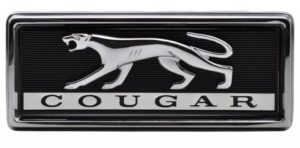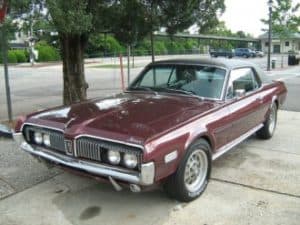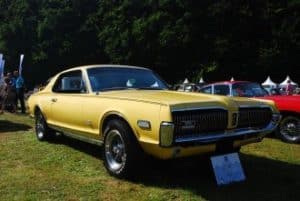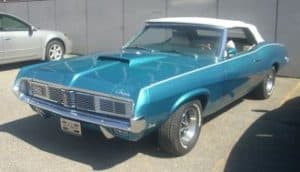
The 1967 Cougar was based on that year’s new second-generation Mustang, but with a 3 inch longer wheelbase and new sheet metal. A full-width divided grille with hidden headlamps and vertical bars defined the front fascia—it was sometimes called the electric shaver grille. At the rear, a similar treatment saw the license plate surrounded on both sides with vertically slatted grillework concealing tailights (with sequential turn signals), a styling touch taken from the Thunderbird. A deliberate effort was made to give the car a more “European” flavor than the Mustang, at least to American buyers’ eyes. Aside from the base model and the luxurious XR-7, only one trim package was available for either model: the sporty GT. The XR-7 model brought a wood-grained steering wheel, a simulated wood-grained dashboard with a full set of black-faced competition instruments and toggle switches, an overhead console, a T-type center automatic transmission shifter, and leather or vinyl seats. The GT package, meanwhile, supplied a much larger engine, Ford’s 390 in³ (6.4 L) FE-series big block to replace the small-block 289 in³ (4.7 L) standard powerplant. Along with this came an upgraded suspension to handle the extra weight of the big engine and give better handling, more powerful brakes, better tires and a low-restriction exhaust system. The Cougar was Motor Trend magazine’s Car of the Year for 1967.
The Cougar continued to be a Mustang twin for seven years, and could be optioned as a genuine muscle car. Nevertheless, it gradually tended to shift away from performance and toward luxury, evolving into something new in the market—a plush pony car. The signs were becoming clear as early as 1970, when a special edition styled by fashion designer Pauline Trigere appeared, complete with a hound’s-tooth pattern vinyl roof. A reskinning in 1971 saw the hidden headlights vanish for good, although hidden wipers were adopted. Between 1969 and 1973, Cougar convertibles were offered.
The introduction of the Cougar finally gave Mercury its own pony car. Slotted between the Ford Mustang and the Ford Thunderbird, the Cougar would be the performance icon and eventually the icon for the Mercury name for several decades. The Cougar was available in two models (base and XR-7) and only came in one body style (a two door hardtop). Engine choices ranged from the 200 hp (149 kW) 289 in³ 2-barrel V8 to the 335 hp (250 kW) 390 in³ 4-barrel V8. A notable performance package called the GT was available on both the base and XR-7 Cougars. This included the 390 in³ V8 as well as a performance handling package and other performance goodies.
Not much changed for the Cougar in its second year. The addition of federally mandated side marker lights was the major change. But the biggest changes were under the hood and performance-wise for the XR-7 model. Three new engines were added to the option list this year—the 230 hp (172 kW) 302 in³, 4-barrel V8; the 335 hp (250 kW) 428 in³, 4-barrel V8; and the 390 hp (291 kW) 427 in³, 4-barrel V8. Mercury was serious about the Cougar being the performance icon for the company. The XR-7G, named for Mercury road racer Dan Gurney, came with all sorts of performance add-ons, including a hood scoop, Lucas fog lamps and hood pins. Engine selection was limited only to the 302, 390 and the 428 V8, a grand total of 619 XR-7G’s were produced, and only 14 G’s were produced with the 428 CJ. The mid-year 7.0 L GT-E package was available on both the standard and XR-7 Cougars and came with the 427 V8. The 428 Cobra Jet Ram Air was available in limited numbers on the GT-E towards the end of the model year. Conservatively rated at 335 hp (250 kW) , the 428 Cobra Jet could produce much more (306 kW (410 hp)) from the factory.
The third year of production, 1969, brought several new additions to the Cougar lineup. A convertible model was now available in both standard and XR-7 trim. These highly anticipated soft tops proved quite popular and today are considered, by many, among the most desirable of the ’67-’70 production run. Exterior-wise, the grille switched from vertical bars to horizontal bars, and a spoiler and a Ram Air induction hood scoop were added as options. A new performance package appeared and several disappeared. The XR-7G and the 7.0 L GT-E disappeared, but the 390 and 428 V8s remained. The 290 hp (216 kW) 351 Windsor V8 was added to the engine lineup. The Eliminator performance package appeared for the first time. A standard 351 in 4-barrel V8 under the hood, with the 390 4-barrel V8, the 428CJ and the Boss 302 available as an option. The Eliminator was the new top of the line performance model of the Cougar lineup. It also featured a blacked-out grille, special side stripes, front and rear spoilers, optional Ram Air induction system, and a more performance tuned suspension and handling package. It also came in a variety of vibrant colors like White, Bright Blue Metallic, Competition Orange, and Bright Yellow. Only 2 Cougars came with the Boss 429 V8, making them the rarest Cougars ever built.
The 1970 Cougar appearance wise was similar to the 1969 model, however there were numerous changes inside and out. It now sported a new front end which featured a pronounced center hood extension and electric shaver grille similar to the 1967 and 1968 Cougars. Federally mandated locking steering columns took place on the inside, and the aforementioned new nose and taillight bezels updated the look on the outside. The 300 hp (224 kW) 351 “Cleveland” V8 was now available for the first time though both the Cleveland and Windsor engines were available if you took the base model 2-barrel motor. The 390 Ford FE engine was now dropped from the lineup, and the Boss 302 and 428CJ engines soldiered along.
1967 Cougar |
||||||||||||||||||||
 |
||||||||||||||||||||
|
||||||||||||||||||||
1968 Cougar |
||||||||||||||||||||
 |
||||||||||||||||||||
|
||||||||||||||||||||
1969 Cougar |
||||||||||||||||||||
 |
||||||||||||||||||||
|
||||||||||||||||||||
1970 Cougar |
||||||||||||||||||||
 |
||||||||||||||||||||
|
||||||||||||||||||||

